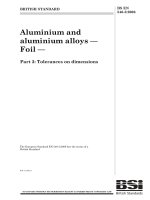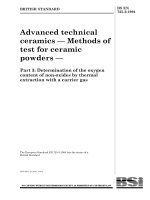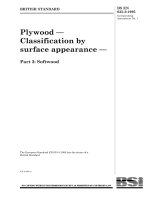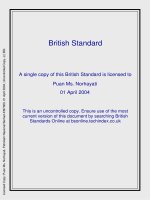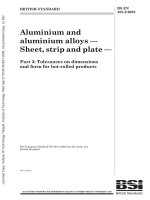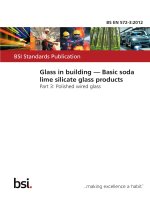Bsi bs en 61076 3 110 2016
Bạn đang xem bản rút gọn của tài liệu. Xem và tải ngay bản đầy đủ của tài liệu tại đây (2.22 MB, 24 trang )
BS EN 61076-3-110:2016
BSI Standards Publication
Connectors for electronic
equipment — Product
requirements
Part 3-110: Detail specification for free
and fixed connectors for data transmission
with frequencies up to 3 000 MHz
BRITISH STANDARD
BS EN 61076-3-110:2016
National foreword
This British Standard is the UK implementation of EN 61076-3-110:2016.
It is identical to IEC 61076-3-110:2016. It supersedes BS EN 61076-3-110:2012
which is withdrawn.
The UK participation in its preparation was entrusted to Technical
Committee EPL/48, Electromechanical components and mechanical
structures for electronic equipment.
A list of organizations represented on this committee can be obtained on
request to its secretary.
This publication does not purport to include all the necessary provisions of
a contract. Users are responsible for its correct application.
© The British Standards Institution 2016.
Published by BSI Standards Limited 2016
ISBN 978 0 580 86061 4
ICS 31.220.10
Compliance with a British Standard cannot confer immunity from
legal obligations.
This British Standard was published under the authority of the
Standards Policy and Strategy Committee on 31 December 2016.
Amendments/corrigenda issued since publication
Date
Text affected
BS EN 61076-3-110:2016
EUROPEAN STANDARD
EN 61076-3-110
NORME EUROPÉENNE
EUROPÄISCHE NORM
November 2016
ICS 31.220.10
Supersedes EN 61076-3-110:2012
English Version
Connectors for electronic equipment - Product requirements Part 3-110: Detail specification for free and fixed connectors for
data transmission with frequencies up to 3 000 MHz
(IEC 61076-3-110:2016)
Connecteurs pour équipements électroniques - Exigences
de produit - Partie 3-110: Spécification particulière pour les
fiches et les embases pour la transmission de données à
des fréquences jusqu'à 3 000 MHz
(IEC 61076-3-110:2016)
Steckverbinder für elektronische Einrichtungen Produktanforderungen - Teil 3-110: Bauartspezifikation für
freie und feste Steckverbinder für Datenübertragungen bis 3
000 MHz
(IEC 61076-3-110:2016)
This European Standard was approved by CENELEC on 2016-10-04. CENELEC members are bound to comply with the CEN/CENELEC
Internal Regulations which stipulate the conditions for giving this European Standard the status of a national standard without any alteration.
Up-to-date lists and bibliographical references concerning such national standards may be obtained on application to the CEN-CENELEC
Management Centre or to any CENELEC member.
This European Standard exists in three official versions (English, French, German). A version in any other language made by translation
under the responsibility of a CENELEC member into its own language and notified to the CEN-CENELEC Management Centre has the
same status as the official versions.
CENELEC members are the national electrotechnical committees of Austria, Belgium, Bulgaria, Croatia, Cyprus, the Czech Republic,
Denmark, Estonia, Finland, Former Yugoslav Republic of Macedonia, France, Germany, Greece, Hungary, Iceland, Ireland, Italy, Latvia,
Lithuania, Luxembourg, Malta, the Netherlands, Norway, Poland, Portugal, Romania, Slovakia, Slovenia, Spain, Sweden, Switzerland,
Turkey and the United Kingdom.
European Committee for Electrotechnical Standardization
Comité Européen de Normalisation Electrotechnique
Europäisches Komitee für Elektrotechnische Normung
CEN-CENELEC Management Centre: Avenue Marnix 17, B-1000 Brussels
© 2016 CENELEC All rights of exploitation in any form and by any means reserved worldwide for CENELEC Members.
Ref. No. EN 61076-3-110:2016 E
BS EN 61076-3-110:2016
EN 61076-3-110:2016
European foreword
The text of document 48B/2496/FDIS, future edition 3 of IEC 61076-3-110, prepared by
SC 48B “Electrical connectors” of IEC/TC 48 “Electrical connectors and mechanical structures for
electrical and electronic equipment" was submitted to the IEC-CENELEC parallel vote and approved
by CENELEC as EN 61076-3-110:2016.
The following dates are fixed:
•
latest date by which the document has to be
implemented at national level by
publication of an identical national
standard or by endorsement
(dop)
2017-07-04
•
latest date by which the national
standards conflicting with the
document have to be withdrawn
(dow)
2019-10-04
This document supersedes EN 61076-3-110:2012.
Attention is drawn to the possibility that some of the elements of this document may be the subject of
patent rights. CENELEC [and/or CEN] shall not be held responsible for identifying any or all such
patent rights.
Endorsement notice
The text of the International Standard IEC 61076-3-110:2016 was approved by CENELEC as a
European Standard without any modification.
In the official version, for Bibliography, the following notes have to be added for the standards indicated:
2
IEC 60068-2-38
NOTE
Harmonized as EN 60068-2-38.
IEC 60603-7-81:2015
NOTE
Harmonized as EN 60603-7-81:2016 (not modified).
IEC 61076 Series
NOTE
Harmonized as EN 61076 Series.
IEC 61076-3:2008
NOTE
Harmonized as EN 61076-3:2008 (not modified).
BS EN 61076-3-110:2016
EN 61076-3-110:2016
Annex ZA
(normative)
Normative references to international publications
with their corresponding European publications
The following documents, in whole or in part, are normatively referenced in this document and are
indispensable for its application. For dated references, only the edition cited applies. For undated
references, the latest edition of the referenced document (including any amendments) applies.
NOTE 1 When an International Publication has been modified by common modifications, indicated by (mod), the relevant
EN/HD applies.
NOTE 2 Up-to-date information on the latest versions of the European Standards listed in this annex is available here:
www.cenelec.eu
Publication
Year
Title
EN/HD
Year
IEC 60068-1
-
Environmental testing Part 1: General and guidance
EN 60068-1
-
IEC 60512
Series
Connectors for electronic equipment Tests and measurements
EN 60512
Series
IEC 60512-1
-
Connectors for electronic equipment Tests and measurements Part 1: General
EN 60512-1
-
IEC 60512-25-9
-
Connectors for electronic equipment EN 60512-25-9
Tests and measurements Part 25-9: Signal integrity tests - Test 25i:
Alien crosstalk
-
IEC 60512-28-100 -
Connectors for electronic equipment Tests and measurements Part 28-100: Signal integrity tests up to
1 000 MHz on IEC 60603-7 and IEC
61076-3 series connectors - Tests 28a to
28g
EN 60512-28-100
-
IEC 60603-7
-
Connectors for electronic equipment Part 7: Detail specification for 8-way,
unshielded, free and fixed connectors
EN 60603-7
-
IEC 60603-7-1
-
Connectors for electronic equipment Part 7-1: Detail specification for 8-way,
shielded, free and fixed connectors
EN 60603-7-1
-
IEC 60603-7-7
2010
Connectors for electronic equipment EN 60603-7-7
Part 7-7: Detail specification for 8-way,
shielded, free and fixed connectors for data
transmission with frequencies up to 600
MHz
2010
IEC 60603-7-71
-
Connectors for electronic equipment Part 7-71: Detail specification for 8-way,
shielded, free and fixed connectors, for
data transmission with frequencies up to
1000 MHz
-
EN 60603-7-71
3
BS EN 61076-3-110:2016
EN 61076-3-110:2016
Publication
Year
Title
EN/HD
Year
IEC 60603-7-82
2016
Connectors for electronic equipment Part 7-82: Detail specification for 8-way,
12 contacts, shielded, free and fixed
connectors, for data transmission with
frequencies up to 2 000 MHz
EN 60603-7-82
201X
IEC 61076-1
-
Connectors for electronic equipment Product requirements Part 1: Generic specification
EN 61076-1
-
IEC 62153-4-15
2015
Metallic communication cable test methods - Part 4-15: Electromagnetic compatibility
(EMC) - Test method for measuring
transfer impedance and screening
attenuation - or coupling attenuation with
triaxial cell
1)
4
To be published.
-
1)
–2–
BS EN 61076-3-110:2016
IEC 61076-3-110:2016 © IEC 2016
CONTENTS
FOREWORD ......................................................................................................................... 4
INTRODUCTION ................................................................................................................... 6
1
Scope ............................................................................................................................ 7
2
Normative references..................................................................................................... 7
3
Terms and definitions .................................................................................................... 8
4
Common features and isometric view ............................................................................. 9
4.1
General ................................................................................................................. 9
4.2
Cable terminations and internal connections – Fixed and free connectors ............. 10
4.3
Mating information .............................................................................................. 10
4.4
Mounting information ........................................................................................... 10
5
Gauges ....................................................................................................................... 11
6
Characteristics ............................................................................................................ 11
6.1
6.2
General ............................................................................................................... 11
Classification into climate categories, clearance and creepage distances and
current carrying capacity ..................................................................................... 11
6.3
Electrical characteristics ...................................................................................... 11
6.4
Transmission characteristics ............................................................................... 11
6.4.1
General ....................................................................................................... 11
6.4.2
Insertion loss (IL) ......................................................................................... 11
6.4.3
Return loss (RL) ........................................................................................... 11
6.4.4
Propagation delay ........................................................................................ 12
6.4.5
Delay skew .................................................................................................. 12
6.4.6
Near-end crosstalk (NEXT) ........................................................................... 12
6.4.7
Power sum NEXT (PSNEXT) (for information only) ....................................... 12
6.4.8
Far-end crosstalk (FEXT) ............................................................................. 12
6.4.9
Power sum FEXT (PSFEXT) (for information only) ........................................ 12
6.4.10
Transverse conversion loss (TCL) ................................................................ 12
6.4.11
Transverse conversion transfer loss (TCTL) .................................................. 12
6.4.12
Power sum alien (exogenous) NEXT (PSANEXT) .......................................... 13
6.4.13
Power sum alien (exogenous) FEXT (PSAFEXT) .......................................... 13
6.4.14
Coupling attenuation .................................................................................... 13
6.5
Mechanical characteristics .................................................................................. 13
7
Test schedule .............................................................................................................. 13
7.1
General ............................................................................................................... 13
7.2
Test schedule ..................................................................................................... 14
7.2.1
Test group EP .............................................................................................. 14
Annex A (normative) Gauging requirements ........................................................................ 15
A.1
Fixed connectors ................................................................................................. 15
A.2
Free connectors .................................................................................................. 15
Bibliography ....................................................................................................................... 16
Figure 1 – Isometric view of fixed cable connector and free 4, 6 and 2 pair connectors,
examples .............................................................................................................................. 9
Figure 2 – Isometric view of fixed board connector, example ................................................ 10
BS EN 61076-3-110:2016
IEC 61076-3-110:2016 © IEC 2016
–3–
Figure 3 – Fixed connector pin numbering assignments (front view of connector),
example ............................................................................................................................. 10
Table 1 – Test group EP ..................................................................................................... 14
–4–
BS EN 61076-3-110:2016
IEC 61076-3-110:2016 © IEC 2016
INTERNATIONAL ELECTROTECHNICAL COMMISSION
____________
CONNECTORS FOR ELECTRONIC EQUIPMENT –
PRODUCT REQUIREMENTS –
Part 3-110: Detail specification for free and fixed connectors
for data transmission with frequencies up to 3 000 MHz
FOREWORD
1) The International Electrotechnical Commission (IEC) is a worldwide organization for standardization comprising
all national electrotechnical committees (IEC National Committees). The object of IEC is to promote
international co-operation on all questions concerning standardization in the electrical and electronic fields. To
this end and in addition to other activities, IEC publishes International Standards, Technical Specifications,
Technical Reports, Publicly Available Specifications (PAS) and Guides (hereafter referred to as “IEC
Publication(s)”). Their preparation is entrusted to technical committees; any IEC National Committee interested
in the subject dealt with may participate in this preparatory work. International, governmental and nongovernmental organizations liaising with the IEC also participate in this preparation. IEC collaborates closely
with the International Organization for Standardization (ISO) in accordance with conditions determined by
agreement between the two organizations.
2) The formal decisions or agreements of IEC on technical matters express, as nearly as possible, an international
consensus of opinion on the relevant subjects since each technical committee has representation from all
interested IEC National Committees.
3) IEC Publications have the form of recommendations for international use and are accepted by IEC National
Committees in that sense. While all reasonable efforts are made to ensure that the technical content of IEC
Publications is accurate, IEC cannot be held responsible for the way in which they are used or for any
misinterpretation by any end user.
4) In order to promote international uniformity, IEC National Committees undertake to apply IEC Publications
transparently to the maximum extent possible in their national and regional publications. Any divergence
between any IEC Publication and the corresponding national or regional publication shall be clearly indicated in
the latter.
5) IEC itself does not provide any attestation of conformity. Independent certification bodies provide conformity
assessment services and, in some areas, access to IEC marks of conformity. IEC is not responsible for any
services carried out by independent certification bodies.
6) All users should ensure that they have the latest edition of this publication.
7) No liability shall attach to IEC or its directors, employees, servants or agents including individual experts and
members of its technical committees and IEC National Committees for any personal injury, property damage or
other damage of any nature whatsoever, whether direct or indirect, or for costs (including legal fees) and
expenses arising out of the publication, use of, or reliance upon, this IEC Publication or any other IEC
Publications.
8) Attention is drawn to the Normative references cited in this publication. Use of the referenced publications is
indispensable for the correct application of this publication.
9) Attention is drawn to the possibility that some of the elements of this IEC Publication may be the subject of
patent rights. IEC shall not be held responsible for identifying any or all such patent rights.
International Standard IEC 61076-3-110 has been prepared by subcommittee 48B: Electrical
connectors, of IEC technical committee 48: Electrical connectors and mechanical structures
for electrical and electronic equipment.
This third edition cancels and replaces the second edition published in 2012. This edition
constitutes a technical revision.
The main technical changes with regard to the previous edition are as follows:
•
IEC 61076-3-110 series connectors have been updated to support intermateability with
IEC 60603-7-82 (up to 2 000 MHz) connectors, in addition to IEC 60603-7-71 (up to
1 000 MHz) connectors and IEC 60603-7-7 (up to 600 MHz) connectors for prior editions;
•
the specifications cover electrical transmission requirements for frequencies up to
3 000 MHz.
BS EN 61076-3-110:2016
IEC 61076-3-110:2016 © IEC 2016
–5–
The text of this standard is based on the following documents:
FDIS
Report on voting
48B/2496/FDIS
48B/2509/RVD
Full information on the voting for the approval of this standard can be found in the report on
voting indicated in the above table.
This publication has been drafted in accordance with the ISO/IEC Directives, Part 2.
A list of all parts of IEC 61076 series, under the general title Connectors for electronic
equipment – Product requirements, can be found on the IEC website.
The committee has decided that the contents of this publication will remain unchanged until
the stability date indicated on the IEC website under "" in the data
related to the specific publication. At this date, the publication will be
•
reconfirmed,
•
withdrawn,
•
replaced by a revised edition, or
•
amended.
–6–
BS EN 61076-3-110:2016
IEC 61076-3-110:2016 © IEC 2016
INTRODUCTION
This detail specification describes connectors according to the IEC 61076-3 series connector
requirements.
This detail specification describes connectors that are similar to, intermateable with, and
intended to be used with IEC 60603-7 series connectors.
The IEC 61076-3-110 series connectors include alternative arrangements of additional
contacts and features, which extend the functionality of the IEC 60603-7 series connectors.
This detail specification covers electrical transmission requirements for frequencies up to
3 000 MHz.
This detail specification describes connectors that support unshielded and three types of
shielded cables used with separated pairs of contacts: individual pair unshielded, with or
without an overall shield; and individual pair shielded, with or without an overall shield.
The IEC 60603-7 series connectors are typically used in ISO/IEC 11801 balanced cabling
systems. The ISO/IEC 11801 balanced cabling systems are organized by categories
according to frequency range and by basic cabling types according to shielding
configurations.
Typically a IEC 61076-3-110 free connector, using the alternative four separated pairs’
contacts, is mated with the IEC 60603-7-7, IEC 60603-7-71, or IEC 60603-7-82 fixed
connectors operating in their higher-frequency mode.
The complete requirements for the connectors described herein are comprised by this detail
specification and the current editions of IEC 61076-3 and IEC 60603-7 series, particularly
IEC 60603-7-1, IEC 60603-7-7, IEC 60603-7-71, and IEC 60603-7-82, which are referenced
herein accordingly.
BS EN 61076-3-110:2016
IEC 61076-3-110:2016 © IEC 2016
–7–
CONNECTORS FOR ELECTRONIC EQUIPMENT –
PRODUCT REQUIREMENTS –
Part 3-110: Detail specification for free and fixed connectors
for data transmission with frequencies up to 3 000 MHz
1
Scope
This part of IEC 61076 is a detail specification for two-part rectangular connectors.
This detail specification covers mechanical, electrical and environmental requirements and
electrical transmission requirements for frequencies up to 3 000 MHz.These connector’s
transmission requirements are specifically intended for specific pairs of contacts, which are
separated from the other pairs of contacts, such as by means of individual pair shields within
the connector.
These connectors are similar to, intermateable with, and intended to be used with the
IEC 60603-7 series connectors.
The IEC 60603-7 series connectors are typically used in ISO/IEC 11801 balanced cabling
systems. The ISO/IEC 11801 balanced cabling systems are organized by categories
according to frequency range and by basic cabling component types, e.g. according to
shielding configurations.
A primary common feature among the IEC 60603-7 series connectors is backward
compatibility to lower frequency categories. The IEC 61076-3-110 series connectors are
backward compatible with IEC 60603-7-7, IEC 60603-7-71 and IEC 60603-7-82 connectors.
The IEC 61076-3-110 series connectors are not backward compatible with some IEC 60603-7
series connectors.
2
Normative references
The following documents, in whole or in part, are normatively referenced in this document and
are indispensable for its application. For dated references, only the edition cited applies. For
undated references, the latest edition of the referenced document (including any
amendments) applies.
IEC 60068-1,
Environmental testing – Part 1: General and guidance
IEC 60512 (all parts),
IEC 60512-1,
General
Connectors for electronic equipment – Tests and measurements
Connectors for electronic equipment – Tests and measurements – Part 1:
IEC 60512-25-9, Connectors for electronic equipment – Tests and measurements –
Part 25-9: Signal integrity tests – Test 25i: Alien crosstalk
–8–
BS EN 61076-3-110:2016
IEC 61076-3-110:2016 © IEC 2016
IEC 60512-28-100, Connectors for electronic equipment – Tests and measurements –
Part 28-100: Signal integrity tests up to 1 000 MHz on IEC 60603-7 and IEC 61076-3 series
connectors – Tests 28a to 28g 1
IEC 60603-7, Connectors for electronic equipment – Part 7: Detail specification for 8-way,
unshielded, free and fixed connectors
IEC 60603-7-1, Connectors for electronic equipment – Part 7-1: Detail specification for 8way, shielded, free and fixed connectors
IEC 60603-7-7:2010, Connectors for electronic equipment – Part 7-7: Detail specification for
8-way, shielded, free and fixed connectors for data transmission with frequencies up to
600 MHz
IEC 60603-7-71, Connectors for electronic equipment – Part 7-71: Detail specification for
8-way, shielded, free and fixed connectors for data transmission with frequencies up to
1 000 MHz
IEC 60603-7-82:—, Connectors for electronic equipment – Part 7-82: Detail specification for
8-way, 12 contacts, shielded, free and fixed connectors, for data transmission with
frequencies up to 2 000 MHz 2
IEC 61076-1,
specification
Connectors for electronic equipment – Product requirements – Part 1: Generic
IEC 62153-4-15:2015, Metallic communication cable test methods – Part 4-15:
Electromagnetic compatibility (EMC) – Test method for measuring transfer impedance and
screening attenuation – or coupling attenuation with triaxial cell
3
Terms and definitions
For the purposes of this document, the terms and definitions given in 2.1
IEC 61076-1:2006, some terms and definitions from IEC 60512-1, and the following apply.
of
3.1
backward compatibility
set of requirements which ensure that a free or fixed connector which is in compliance with
this standard, when mated with a fixed or free connector in compliance with a lower frequency
IEC 60603-7 series connector, fully complies with the transmission performance requirements
of the lower frequency IEC 60603-7 series connector.
Note 1 to entry: These IEC 61076-3-110 series connectors are backward compatible with IEC 60603-7-7,
IEC 60603-7-71 and IEC 60603-7-82 connectors, and other IEC 60603-7 series connectors.
Note 2 to entry: The complete specification of the categories and the backward compatibility system for the
IEC 60603-7 series connectors, when used in standard balanced cabling systems, is specified in referenced
ISO/IEC 11801.
[SOURCE: IEC 60603-7-81:2015, 3.1, modified – The definition has been updated, Note 1 to
entry has been modified and is now Note 2, a new Note 1 has been added and the additional
reference to Clause 3 of IEC 60603-7-1:2011 has been deleted.]
___________
1
The tests include frequencies up to 2 000 MHz.
2
To be published. Currently at FDIS stage. Is likely to be published at the same time as this document.
BS EN 61076-3-110:2016
IEC 61076-3-110:2016 © IEC 2016
–9–
3.2
crosstalk loss
near-end-crosstalk (NEXT) and far-end-crosstalk (FEXT), commonly referred to as crosstalk
loss, are the specific transmission characteristics associated with the reverse and forward
crosstalk coupling attenuation between two pairs
4
4.1
Common features and isometric view
General
The IEC 61076-3-110 series connectors include alternative arrangements of additional
contacts and features, which extend the functionality of the IEC 60603-7 series connectors.
The IEC 61076-3-110 series connectors include up to 12 contacts, including up to 8 contacts
(1, 2, 3, 4, 5, 6, 7, 8) that are similar to a standard IEC 60603-7 series connector. In addition,
the IEC 61076-3-110 connector includes up to 4 additional contacts (6’,3’,4’,5’) located on the
side of the connector opposite from the original contacts’ positions of a basic IEC 60603-7
series connector (see Figure 3).
Typically a IEC 61076-3-110 free connector using alternative contacts is used in data
communication cabling systems with the IEC 60603-7-7, IEC 60603-7-71, and
IEC 60603-7-82, fixed connectors.
IEC
Figure 1 – Isometric view of fixed cable connector
and free 4, 6 and 2 pair connectors, examples
BS EN 61076-3-110:2016
IEC 61076-3-110:2016 © IEC 2016
– 10 –
IEC
Figure 2 – Isometric view of fixed board connector, example
Fixed and free connectors may include cavities channels and related switch actuator
protrusions for engaging features within IEC 60603-7-7, IEC 60603-7-71, and IEC 60603-7-82
connectors (see Figure 1 and Figure 2).
See IEC 60603-7-7 and IEC 60603-7-1 for views, dimensions and requirements.
4.2
Cable terminations and internal connections – Fixed and free connectors
These connectors typically use pin and pair numbering and grouping assignments similar to
the IEC 60603-7 series connectors, as shown in Figure 3. The 8-contact type typically uses
contact numbers 1, 2, 7, 8, 6’, 3’, 4’, 5’. The 4-contact type may use contact numbers 1, 2, 7,
8. For transmission requirements for the special case when contact numbers 3, 4, 5, 6, are
arranged in pair combinations 3-6, 4-5, see other IEC 60603-7 series standards.
The complete specification for the pin and pair numbering and grouping assignments, for the
IEC 60603-7 series connectors used in balanced cabling systems is specified in
ISO/IEC 11801.
1
6’
2
3’
3
4
5
6
7
8
4’
5’
IEC
Figure 3 – Fixed connector pin numbering
assignments (front view of connector), example
See IEC 60603-7-7 for cable termination and internal connection types.
4.3
Mating information
See IEC 60603-7-7 and IEC 60603-7-1 for views, dimensions and requirements.
4.4
Mounting information
Fixed and free connector mounting information is not specified and is to be determined by the
manufacturer.
BS EN 61076-3-110:2016
IEC 61076-3-110:2016 © IEC 2016
5
– 11 –
Gauges
The gauges as defined by IEC 60603-7, IEC 60603-7-7 shall apply.
6
Characteristics
6.1
General
All requirements and test schedules apply to the entire mated connectors unless otherwise
specified.
6.2
Classification into climate categories, clearance and creepage distances and
current carrying capacity
The relevant requirements of IEC 60603-7-7 and of IEC 60603-7-1 apply.
6.3
Electrical characteristics
Connectors according to IEC 61076-3-110 shall also conform to the electrical characteristics
specified by IEC 60603-7-7.
6.4
6.4.1
Transmission characteristics
General
Compliance to this standard in respect to transmission characteristics, is determined
according to specific test methods described in test group EP, see Table 1. The
interoperability of connectors compliant to this standard shall be demonstrated by testing the
connectors according to IEC 60512-28-100 procedures, unless stated otherwise, for
2 000 MHz, adapted to 3 000 MHz by increasing the upper frequency limit of all
measurements of transmission parameters and the same time extending the test parameters
using the same formulas as to be used up to 2 000 MHz.
These transmission performance requirements apply to mated connectors.
These transmission performance requirements apply to all separated pairs of contacts. In the
case of crosstalk requirements, requirements apply between all combinations of separated
pairs of contacts, e.g. 1-2, 7-8, 3’-6’, 4’-5’, see 4.1.
These transmission performance requirements do not apply to non-separated pairs of
contacts, e.g. 3-6, 4-5 according to IEC 60603-7 series connectors.
In the following sub-clauses, the variable f contained in the equations is the frequency
expressed in MHz.
6.4.2
Insertion loss (IL)
All pairs: ≤0,02 √(f) dB, from 1 MHz to 1 000 MHz.
All pairs: ≤0,02 √(f) + 0,0005 (f − 1 000) dB, from 1 000 MHz to 3 000 MHz
Whenever the formula results in a value less than 0,1 dB, the requirement shall revert to
0,1 dB.
6.4.3
Return loss (RL)
All pairs: ≥72 – 20 log 10 (f) dB, from 1 MHz to 3 000 MHz
– 12 –
BS EN 61076-3-110:2016
IEC 61076-3-110:2016 © IEC 2016
Whenever the formula results in a value less than 12 dB, the requirement shall revert to
12 dB.
Whenever the requirement results in a value greater than 30 dB, the requirement shall revert
to 30 dB.
6.4.4
Propagation delay
All pairs: ≤2,5 ns, from 1 MHz to 3 000 MHz.
Propagation delay test needs not to be performed. It is assumed that connectors comply by
design.
6.4.5
Delay skew
All pairs: ≤1,25 ns, from 1 MHz to 3 000 MHz.
Delay skew test needs not to be performed. It is assumed that connectors comply by design.
6.4.6
Near-end crosstalk (NEXT)
All pair combinations: ≥ 117,4 – 20 log 10 (f) dB, from 1 MHz to 3 000 MHz
Whenever the formula results in a value greater than 80 dB, the requirement shall revert to
80 dB.
6.4.7
Power sum NEXT (PSNEXT) (for information only)
All pair combinations: ≥114,4 – 20 log 10 (f) dB, from 1 MHz to 3 000 MHz.
This characteristic is achieved by compliance to PP NEXT (6.4.6) and there is no necessity to
test it.
6.4.8
Far-end crosstalk (FEXT)
All pair combinations: ≥105 – 20 log 10 (f) dB, from 1 MHz to 3 000 MHz
Whenever the formula results in a value greater than 80 dB, the requirement shall revert to
80 dB.
6.4.9
Power sum FEXT (PSFEXT) (for information only)
All pair combinations: ≥102 – 20 log 10 (f) dB, from 1 MHz to 3 000 MHz.
This characteristic is achieved by compliance to PP FEXT (6.4.8) and there is no necessity to
test it.
6.4.10
Transverse conversion loss (TCL)
All pairs: ≥74 – 20 log 10 (f) dB, from 1 MHz to 3 000 MHz.
Whenever the formula results in a value greater than 40 dB, the requirement shall revert to
40 dB.
6.4.11
Transverse conversion transfer loss (TCTL)
All pairs: ≥78 – 20 log 10 (f) dB, from 1 MHz to 3 000 MHz.
BS EN 61076-3-110:2016
IEC 61076-3-110:2016 © IEC 2016
– 13 –
Whenever the formula results in a value greater than 40 dB, the requirement shall revert to
40 dB.
6.4.12
Power sum alien (exogenous) NEXT (PSANEXT)
All pair combinations: ≥135,5 – 20 log 10 (f) dB, from 1 MHz to 3 000 MHz.
Whenever the formula results in a value greater than 84 dB, the requirement shall revert to
84 dB.
The PS ANEXT and PS AFEXT requirements are fulfilled when the coupling attenuation is
verified, and it is 25 dB better than the PS ANEXT and the PS AFEXT minimum requirements.
6.4.13
Power sum alien (exogenous) FEXT (PSAFEXT)
All pair combinations: ≥128,8 – 20 log 10 (f) dB, from 1 MHz to 3 000 MHz.
Whenever the formula results in a value greater than 84 dB, the requirement shall revert to
84 dB.
The PS ANEXT and PS AFEXT requirements are fulfilled when the coupling attenuation is
verified and it is 25 dB better than the PS ANEXT and the PS AFEXT minimum requirements.
6.4.14
Coupling attenuation
IEC 62153-4-15 coupling attenuation with triaxial cell.
All pairs: ≥85 – 20 log 10 (f) dB, from 30 MHz to 3 000 MHz.
Whenever the formula results in a value greater than 85 dB, the requirement shall revert to
85 dB.
The coupling attenuation requirement is assumed to be fulfilled when the transfer impedance
and unbalance attenuation (transverse conversion loss and transverse conversion transfer
loss) requirements are met on the full bandwidth.
6.5
Mechanical characteristics
See 6.6 of IEC 60603-7-7:2010 for mechanical characteristic requirements.
7
7.1
Test schedule
General
This test schedule shows the tests and the order in which they shall be carried out, as well as
the requirements to be met.
Unless otherwise specified, all tests shall be carried out under standard atmospheric
conditions for testing as specified in IEC 60068-1, as directed by the applicable part of
IEC 60512.
See Clause 7 of IEC 60603-7-7:2010 for test schedules and requirements for test groups AP,
BP, CP, DP, FP and GP.
– 14 –
7.2
BS EN 61076-3-110:2016
IEC 61076-3-110:2016 © IEC 2016
Test schedule
7.2.1
Test group EP
All specimens shall be subjected to the following tests (see Table 1).
Table 1 – Test group EP
Test
phase
Test
Title
IEC 60512
Test No.
Severity or condition
of test
EP1
All pairs
EP2
Measurement to be performed
Title
Insertion loss
IEC standard
Requirements
60512-28-100
Per 6.4.2
All pairs, both directions NEXT loss
(pair to pair)
60512-28-100
Per 6.4.6
EP3
All pairs, both directions Return loss
60512-28-100
Per 6.4.3
EP4
All pairs, both directions FEXT loss
(pair to pair)
60512-28-100
Per 6.4.8
EP5
All pairs, both directions Transverse
conversion loss
60512-28-100
Per 6.4.10
EP6
All pairs, both directions Transverse
conversion
transfer loss
60512-28-100
Per 6.4.11
EP7
All pairs together
Coupling
attenuation
62153-4-15 coupling
attenuation with triaxial cell
Per 6.4.14
EP8
Measurement points
cable termination to
cable termination – as
close to the connector
housings as possible
Input to output
d.c. resistance
60603-7
Per 6.4.5 of
IEC 60603-7:2008
Input to output
d.c. resistance
unbalance
60603-7
Per 6.4.6 of
IEC 60603-7:2008
All input to output
conductor paths
EP9
Measurement points
cable termination to
cable termination – as
close to the connector
housings as possible
All input to output
connector paths
(conductor path to
conductor path)
EP10
All pairs, both directions PSANEXT
60512-25-9
Per 6.4.12
EP11
All pairs, both directions PSAFEXT
60512-25-9
Per 6.4.13
All measurements shall be performed on mated connectors.
BS EN 61076-3-110:2016
IEC 61076-3-110:2016 © IEC 2016
– 15 –
Annex A
(normative)
Gauging requirements
A.1
Fixed connectors
The go gauge specified in Clause 5 shall be capable of being inserted and removed with a
force of 8,9 N maximum.
The no-go gauges specified in Clause 5 shall not be capable of entering the fixed connector
more than 1,78 mm with an 8,9 N insertion force.
A.2
Free connectors
The connector shall be capable of insertion and latching into the go gauge specified in
Clause 5 with a 30 N or less insertion force with the latch bar depressed.
After insertion and latching, the connector shall be capable of removal, with the latch
depressed, with a removal force of 30 N or less applied at an advantageous angle.
The free connectors shall not be capable of entering the no-go gauges specified in Clause 5
more than 1,78 mm with an 8,9 N insertion force.
– 16 –
BS EN 61076-3-110:2016
IEC 61076-3-110:2016 © IEC 2016
Bibliography
IEC 60068-2-38, Environmental testing – Part 2-38: Tests − Test Z/AD: Composite
temperature/humidity cyclic test
IEC 60603-7-81:2015, Connectors for electronic equipment – Part 7-81: Detail specification
for 8-way, shielded, free and fixed connectors, for data transmissions with frequencies up to
2 000 MHz
IEC 61076-3 (all parts),
Connectors for electronic equipment – Product requirements
IEC 61076-3:2008, Connectors for electronic equipment – Product requirements – Part 3:
Rectangular connectors – Sectional specification
ISO/IEC 11801,
Information technology – Generic cabling for customer premises 3
ISO/IEC TR 11801-9901, Information technology – Generic cabling for customer premises –
Part 9901: Guidance for balanced cabling in support of at least 40 Gbit/s data transmission
_____________
___________
3
ISO/IEC 11801-1 to ISO/IEC 11801-6 are under consideration.
This page deliberately left blank
This page deliberately left blank
NO COPYING WITHOUT BSI PERMISSION EXCEPT AS PERMITTED BY COPYRIGHT LAW
British Standards Institution (BSI)
BSI is the national body responsible for preparing British Standards and other
standards-related publications, information and services.
BSI is incorporated by Royal Charter. British Standards and other standardization
products are published by BSI Standards Limited.
About us
Reproducing extracts
We bring together business, industry, government, consumers, innovators
and others to shape their combined experience and expertise into standards
-based solutions.
For permission to reproduce content from BSI publications contact the BSI
Copyright & Licensing team.
The knowledge embodied in our standards has been carefully assembled in
a dependable format and refined through our open consultation process.
Organizations of all sizes and across all sectors choose standards to help
them achieve their goals.
Information on standards
We can provide you with the knowledge that your organization needs
to succeed. Find out more about British Standards by visiting our website at
bsigroup.com/standards or contacting our Customer Services team or
Knowledge Centre.
Buying standards
You can buy and download PDF versions of BSI publications, including British
and adopted European and international standards, through our website at
bsigroup.com/shop, where hard copies can also be purchased.
If you need international and foreign standards from other Standards Development
Organizations, hard copies can be ordered from our Customer Services team.
Copyright in BSI publications
All the content in BSI publications, including British Standards, is the property
of and copyrighted by BSI or some person or entity that owns copyright in the
information used (such as the international standardization bodies) and has
formally licensed such information to BSI for commercial publication and use.
Save for the provisions below, you may not transfer, share or disseminate any
portion of the standard to any other person. You may not adapt, distribute,
commercially exploit, or publicly display the standard or any portion thereof in any
manner whatsoever without BSI’s prior written consent.
Storing and using standards
Standards purchased in soft copy format:
• A British Standard purchased in soft copy format is licensed to a sole named
user for personal or internal company use only.
• The standard may be stored on more than 1 device provided that it is accessible
by the sole named user only and that only 1 copy is accessed at any one time.
• A single paper copy may be printed for personal or internal company use only.
Standards purchased in hard copy format:
• A British Standard purchased in hard copy format is for personal or internal
company use only.
• It may not be further reproduced – in any format – to create an additional copy.
This includes scanning of the document.
If you need more than 1 copy of the document, or if you wish to share the
document on an internal network, you can save money by choosing a subscription
product (see ‘Subscriptions’).
Subscriptions
Our range of subscription services are designed to make using standards
easier for you. For further information on our subscription products go to
bsigroup.com/subscriptions.
With British Standards Online (BSOL) you’ll have instant access to over 55,000
British and adopted European and international standards from your desktop.
It’s available 24/7 and is refreshed daily so you’ll always be up to date.
You can keep in touch with standards developments and receive substantial
discounts on the purchase price of standards, both in single copy and subscription
format, by becoming a BSI Subscribing Member.
PLUS is an updating service exclusive to BSI Subscribing Members. You will
automatically receive the latest hard copy of your standards when they’re
revised or replaced.
To find out more about becoming a BSI Subscribing Member and the benefits
of membership, please visit bsigroup.com/shop.
With a Multi-User Network Licence (MUNL) you are able to host standards
publications on your intranet. Licences can cover as few or as many users as you
wish. With updates supplied as soon as they’re available, you can be sure your
documentation is current. For further information, email
Revisions
Our British Standards and other publications are updated by amendment or revision.
We continually improve the quality of our products and services to benefit your
business. If you find an inaccuracy or ambiguity within a British Standard or other
BSI publication please inform the Knowledge Centre.
Useful Contacts
Customer Services
Tel: +44 345 086 9001
Email (orders):
Email (enquiries):
Subscriptions
Tel: +44 345 086 9001
Email:
Knowledge Centre
Tel: +44 20 8996 7004
Email:
Copyright & Licensing
Tel: +44 20 8996 7070
Email:
BSI Group Headquarters
389 Chiswick High Road London W4 4AL UK


